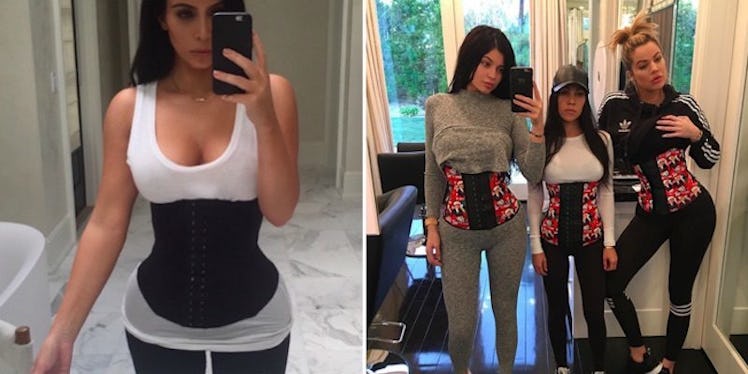
Waist Trainer 101: The History of Women Squishing Our Organs for Beauty
If Kim Kardashian does it, I want to do it too. This means vampire facials, a 72-day marriage, a closet full of bodycon, my very own vanity project app and a waist trainer.
I guess I can't have everything Mrs. Kanye West has, but I can totally purchase a waist trainer and wear it around the house for eight hours.
Although waist training has had its moment in the spotlight and most of the world has dismissed it as a fad, a few celebrities are still posting selfies in skintight foundation garments intended to give your body that tantalizing hourglass curve.
Kimmy K wore her waist trainer on the reg after having North, and she got her sisters into them, too.
I've given up on the illusion of a waist trainer actually working, but I do still lay down on the bed and clasp that sucker on when I'm wearing a super-tight vintage silhouette. Sure, I can't really eat anything more than a string cheese, and a bubbly LaCroix is out of the question, but it looks great and keeps me fitting into my treasured thrift-store Mugler dress.
Women have been “waist training” for hundreds of years. Although today's waist trainers aren't quite on par with, say, Rose DeWitt-Bukater being laced tightly into a corset made of metal, when we cinch ourselves into a waist trainer or another restricting foundation garment, we're just acting out another ritual of womanhood from the past.
Waist training is supposed to teach your body to relocate its fat stores, strengthen your core, whittle down your waist and suppress your appetite, too. The Kardashians didn't invent the waist trainer; they've been around in some form since the It Girl was Queen Elizabeth I.
Corsets and shapers became popular around the 1600s, and women wore them in some shape or form for centuries afterward, often starting in their mid-teens. They hit their zenith in the prim and proper Victorian era when the “in” silhouette was almost obnoxiously curvy, and you wouldn't dare be seen without one unless you were poor or unfashionable.
There were whispers about the negative effects of corsetry, from indigestion to its impact on pregnancy, but women wore them anyway, even if they fainted from lack of oxygen. Hey, anything for a 16-inch waist -- right, Scarlett O' Hara?
In the early 1900s, women donned corsets, but as WWI donned and the war effort needed the metal, corsets fell out of fashion. The '20s and its flappers did away with them almost entirely. The starlets of the '30s could never have worn any foundation garments under those slippery satin bias-cut dresses.
The '50s gave foundation garments new life. Women wore Merry Widow corsets, rubbery girdles and other shapers to give their bodies the appropriate silhouette in styles that mimicked Dior's “New Look,” with its teensy waist and full skirt. If you wear '50s vintage today, you can tell that these women had a little help underneath their clothes. They would totally have posted selfies in their waist trainers -- assuming Instagram had existed in 1953.
In the '90s, the advent of Spanx gave women a slightly less restrictive way to nip and tone under tight skirts and dresses, and the '00s obsession with Herve Leger bodycon dresses kept the focus on your body. We have the Kardashian sisters to thank for the current skintight trend and for the resurgence of public shapewear – Kim's a noted Spanx devotee, when she's not waist training.
However, for the most part, celebs have given up wearing their trainers. It's not exactly effective, says Dr. Mary Jane Minkin.
“Medically, it doesn't make sense that cinching your waist tightly will make it permanently smaller," she told Women's Health. "It's also uncomfortable, restricts your movements and, if you wear it really tight, it can even make it difficult to breathe and theoretically could cause rib damage.”
As someone who once went to the office bathroom to yank off her waist trainer after an ill-advised six hours of wear, I feel that. Yes, that tantalizing hourglass silhouette is tempting, but so is another chocolate chip cookie. I'll leave my waist training to my Monday barre class. I think the ladies of the Victorian era would have done the same if they could.